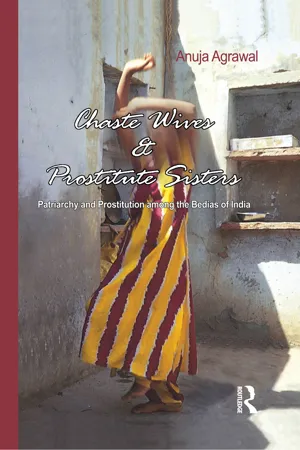
Chaste Wives and Prostitute Sisters
Patriarchy and Prostitution among the Bedias of India
- 264 pages
- English
- ePUB (mobile friendly)
- Available on iOS & Android
Chaste Wives and Prostitute Sisters
Patriarchy and Prostitution among the Bedias of India
About This Book
This book is an anthropological study of the unusual coincidence of prostitution and patriarchy among an extremely marginalized group in north India, the Bedias, who are also a de-notified community.
It is the first detailed account of the implications of a systematic practice of familial prostitution on the kinship structures and marriage practices of a community. This starkly manifests among the Bedias in the clear separation between sisters and daughters who engage in prostitution and wives and daughters-in-law who do not. The Bedias exemplify a situation in which prostitution of young unmarried women is the mainstay of the familial economy of an entire social group. Tracing the recent origins of the practice in the community, the author goes on to explore the manner in which this familial economy manifests itself in the lives of individual women and the kind of family groupings it produces. She then examines the repercussion this economy has on the lives of Bedia men, how the problem of their marriage is resolved, and how the Bedia wives become repositories of female purity which otherwise stands jeopardized by Bedia sisters engaged in prostitution.
Frequently asked questions
Information
1 Prostitution as "Tradition"
Prostitution: An Immemorial Tradition or "Choice" of an Individual?
Prostitution and Tradition
Absence of a Female Line of Descent
Table of contents
- Cover
- Half Title
- Title Page
- Copyright Page
- Dedication
- Contents
- List of Tables
- List of Plates
- Acknowledgments
- Introduction
- 1. Prostitution as "Tradition"
- 2. The Making of a Bedia Prostitute
- 3. Bedia Women and "Love Marriage"
- 4. Prostitution as Family Economy
- 5. Prostitution and the Indolence of Bedia Men
- 6. Prostitution and the Marriage Economy
- 7. The Morality of the Bedia Economy
- Conclusion: Patriarchy and Prostitution
- Appendices
- References
- Index